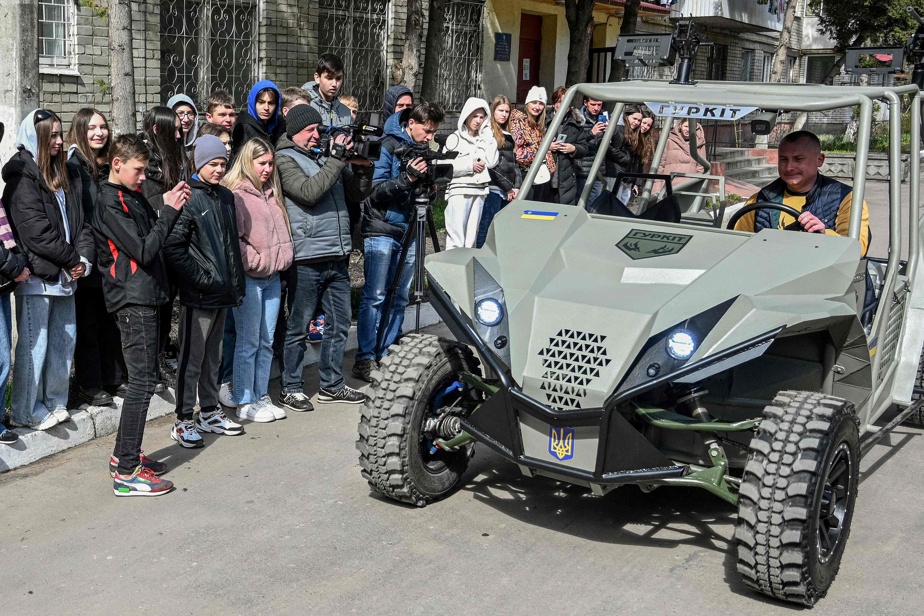(Kyiv) With their chunky wheels, low chassis and painted teeth on the front, Moussa’s remastered buggies look straight out of the Mad Max movies.
Although a little crazy, these machines, robust and fast, are in high demand on the side of the Ukrainian army. Even in the most delicate terrain, they can transport military equipment and repatriate the wounded from the front line.
Ukraine faces a major challenge: to use as many vehicles as possible to transport its units from one area to another, but also to evacuate the many wounded, even though the lifespan of this type of machine at most close to fighting may be limited to a few weeks.
Moussa, 29 – who did not want to give his full identity because his family lives in annexed Crimea under Russian control – started his small business to supply the Ukrainian army with remastered buggies.
This example illustrates the increasingly strong links between private industry and the regular army, at a time when Kyiv needs the maximum equipment in the hope of carrying out an offensive in the East and the South to take back the territories occupied by Russia.
In Kyiv, Moussa and his colleagues are busy creating the metal structure of a buggy. Before having fun presenting another machine that has just been completed, accelerating and braking suddenly for the occasion.
The buggies produced by Moussa and his team – “a few” since last summer – weigh 650 kg, about half of a normal car, and sell for 9,000 Canadian dollars each.
Their craftsmanship is a beautiful mix full of ingenuity: before being assembled, most of the parts are recovered from old cars, without complex electronic systems, so as to facilitate repair in the field.
“These cars, there are plenty of them in Ukraine and they are not expensive,” Moussa told AFP.
The buggy passed through his hands a few moments earlier has also been adapted to the off-road conditions of the battlefield. Its final name: Dracarys, in reference to fire-breathing dragons in the hit series Game of Thrones.
After testing outside of Kyiv, the vehicle will be sent to a battalion called “Crimea” for use in reconnaissance operations.
On the front line, “the lifespan of these vehicles is two or three weeks,” says Moussa. “It’s just a metal set. What matters are the lives” of the soldiers, he continues.
A doctor by profession, he has given up medicine for the time being, determined to help his country by making his DIY buggies.
He belongs to the community of Crimean Tatars, Muslims who largely boycotted the pseudo-unification referendum organized by Moscow in 2014 to annex the peninsula and were subsequently repressed.
Russians “hate freedom,” he blurts out. ” I want to go home. I want to see my family and that’s my personal motivation,” he said again to explain his commitment.
In another workshop on the outskirts of Kyiv, mechanics are working on the manufacture of vehicles for medical purposes, a project led by a Romanian volunteer, Radu Hossu, who has raised funds on social networks.
The goal: to allow medics on the front line, in the Donetsk region, to benefit from a high-performance machine to carry out their missions.
His team planned to assemble several vehicles at a total cost of approximately $225,000.
One of them must be a mixture of the cabin of a Truck truck and the chassis of a Soviet Gas and will be used to evacuate the wounded from the front line. To deal with any eventuality, it will be armored, with large wheels.
“It’s a ‘Frankenstein’ vehicle,” smiles Mr. Hossu, “it doesn’t exist anywhere else.”
The craft isn’t the only impressive example. An old Polish bus, repainted in khaki, will serve as a mobile hospital where war nurses can operate directly.
Inside, a set of modern medical equipment. It too is armored and a mesh is attached in front to limit impacts on the windshield.
This converted bus will be positioned 15 kilometers back from the front line to receive the wounded and provide vital first aid.
Mr. Hossu, a former political consultant, named his humanitarian project in memory of a slain Ukrainian soldier he knew, Oleg Goubal.
This soldier died of his injuries on the way to a hospital. Mr. Hossu wants to prevent this type of situation from happening again as much as possible.
“If (such an organization) had existed…I’m not saying Oleg would necessarily be alive, but it would have given him a chance to survive,” he said.
Once all the vehicles are ready for use, Mr. Hossu plans to continue his commitment and go to Donbass, to help evacuate the wounded from the devastated city of Bakhmout.

